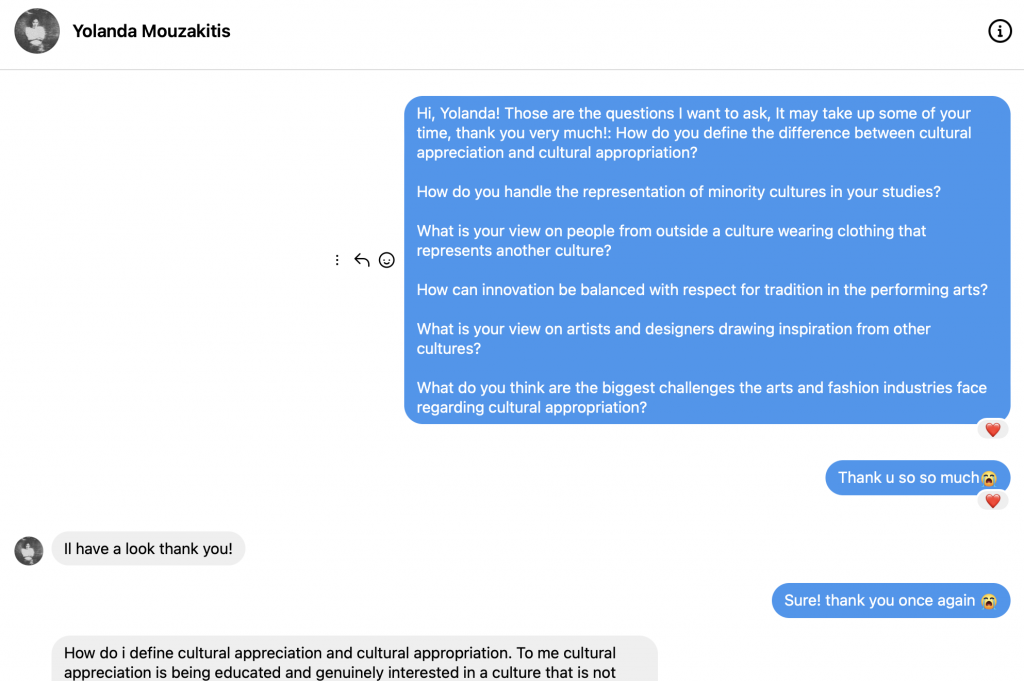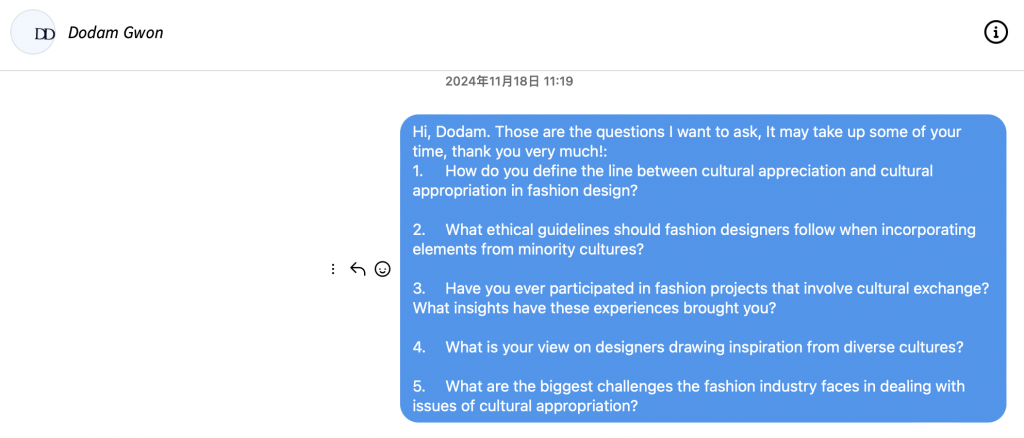I will do offline practice shooting at the end of November to explore whether I can appreciate culture and verify my framework. Before that, I asked two experienced students from different departments of CSM (MA Performance & Screen and BA Menswear). During the text interview, I gained a multicultural understanding of cultural appreciation and appropriation (because they are from different countries, one from the UK and the other from South Korea). We discussed balancing the boundaries between innovation and respect for tradition in fashion design and performing arts. These conversations will help me better apply the framework I developed in practical shooting and ensure cultural elements can be correctly reproduced in the creative process.
Yolanda Mouzakitis emphasized the importance of genuine interest (cultural appreciation). She mentioned that cultural appreciation should be based on a deep understanding of culture (a lot of research must be done). This reminds me to ensure that all cultural elements are accurately presented when shooting, not just for visual effects.
Dodam Gwon’s experience made me think about the need to deeply understand the cultural background and history when designing and avoid perfunctory cultural applications. His insights prompted me to consider how I could convey respect and value for culture through my images rather than using them as a fashion accessory.
Through these preparations and conversations, I realized that my shoots were a form of artistic expression and an opportunity for cultural exchange. This would allow me to test and demonstrate my framework in action, ensuring it would work.
Yolanda Mouzakitis: MA Performance & Screen

In her conversation, Yolanda Mouzakitis clearly defined the difference between cultural appreciation and cultural appropriation. Cultural appreciation is education and a genuine interest in non-native cultures, as well as the desire to use cultural elements in art or style with respect. On the other hand, cultural appropriation is the use of cultural traits that do not belong to one’s own culture because it is cool or to be different, without any connection or understanding of its meaning.
When dealing with minority cultural representations, she strives to operate from her perspective and give everyone an equal opportunity to participate in art. Regarding outsiders wearing clothing representing another culture, she believes it depends on whether the individual is genuinely educated and inspired by another culture. She is open tohis practice as long as the participants understand what they are doing.
Regarding artists and designers borrowing from other cultures, Yolanda believes it is very good to use one’s cultural references and make them part of one’s identity. At the same time, she also believes that it is hypocritical for artists not to be known for using specific cultures that are not their own.
Dodam Gwon: BA – Menswear (Graduated)

In his response, Dodam Gwon shared his thoughts on the boundary between cultural appreciation and cultural appropriation in fashion design. He emphasized the ethical guidelines designers must follow when incorporating minority elements to avoid conveying the wrong cultural ideas.
Although he has not been directly involved in fashion projects involving cultural exchange, interacting with friends from different countries while studying in London has broadened his horizons and made him better understand himself. When designing, he believes that designers should always think about the essence and authenticity of culture. In this sense, drawing inspiration from the culture you were influenced by while growing up seems excellent.
He believes the fashion industry’s biggest challenge in dealing with cultural appropriation is to truly understand and sincerely accept each other, which is both necessary and the most difficult.
———————————————————————————
What I learned from these two interviews:
These two interviews gave me a deep understanding of the boundaries between cultural appreciation and cultural appropriation and the importance of respecting the original culture when creating and performing. Through Yolanda and Dodam’s perspectives, I learned how to handle cultural elements more sensitively and thoughtfully, ensuring creativity and tradition are shown in fashion and performing arts. These experiences and insights will guide me in my future work to better integrate and showcase different cultures, avoid cultural appropriation, and promote accurate understanding and respect between cultures.